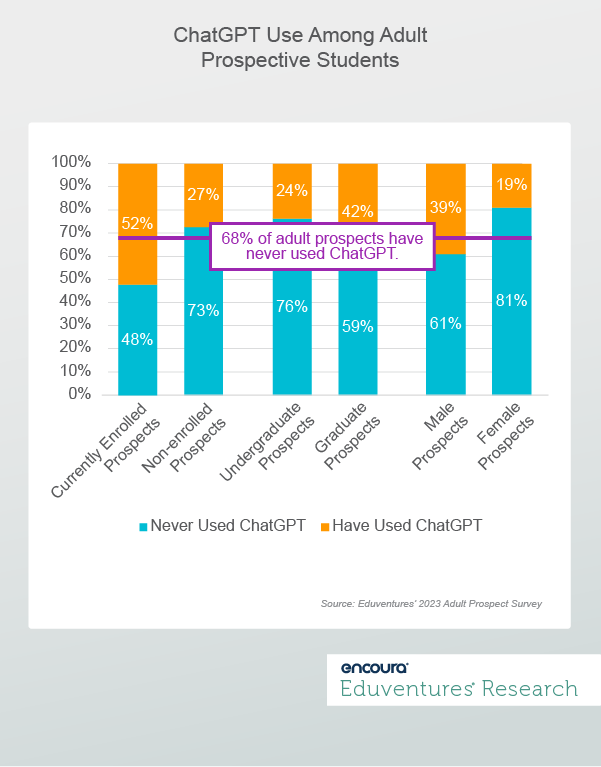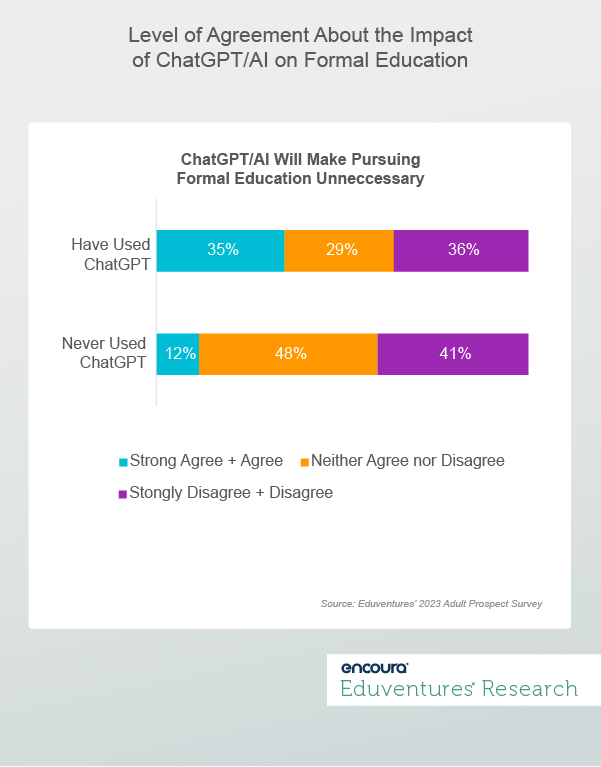As higher education adjusts to the reality and ramifications of artificial intelligence (AI) in teaching and learning, Eduventures checks the pulse of adult prospective students to understand how this is influencing their decisions about pursuing further education.
OpenAI’s Chat Generative Pre-Trained Transformer, or ChatGPT as we know it, exploded onto the scene in 2023. Now in 2024, other generative AI technologies have emerged, including Bard from Google and Grok from X (formerly Twitter), prompting a flurry of speculation about the potential demise of higher education. If these tools can write essays with citations and evade detection by astute faculty, how will institutions be able to judge if students have mastered information?
While plagiarism remains a top concern, Eduventures also sees the potential for recruitment risk. But to understand how the prospective student market will react to this technology, it is important to understand who is using it and whether these tools are sowing doubt about formal education.
Who uses ChatGPT?
In the Eduventures 2023 Adult Prospect Research—our annual study that evaluates adult prospective student behaviors, attitudes, and preferences—we asked about ChatGPT use. In our sample, 32% of adult prospects have used ChatGPT, while the majority (68%) have never used it. Figure 1 shows differences in ChatGPT adoption among various prospective student groups.
Figure 1.
This shows that 42% of graduate prospects (those with a bachelor’s degree or higher) have used ChatGPT compared to just 24% of undergraduate prospects.
Women (19%) are far less likely to have used it than men (39%), which may be explained by occupation and program preference differences. AI-aligned computer and technology occupations typically employ more men than women, while health professions—often dominated by nursing and other helping professions—have historically employed more women.
There are also differences among enrolled and not enrolled prospects. Over half (52%) of currently enrolled prospective students have used ChatGPT, compared to just 27% of non-enrolled prospects. And, nearly one-third of currently enrolled prospects used it once a week or more, perhaps indicating that course enrollment may lead to higher ChatGPT usage.
This would seem to bolster the worries of faculty, but what about the impact on recruiting?
Generative AI and Formal Education
Prospects were asked if they agreed or disagreed with the statement, “ChatGPT/AI will make pursuing formal education unnecessary.” While this statement may seem preposterous to some, it allows us to gauge if ChatGPT and related technologies are having an impact on the choices of prospective students.
Figure 2 shows that 35% of prospects who have used ChatGPT agree with this statement, compared to just 12% of prospects who have never used it. This statistically significant difference implies that the adoption and use of ChatGPT does make some prospects rethink formal education. (But it is also important to recognize that this topic is a moving target and public perception of emerging technology can change quickly.)
Figure 2.
Currently, enrolled prospects (32%) are twice as likely to agree that ChatGPT will make education unnecessary compared to non-enrolled prospects (16%). And, as we found, currently enrolled students are much more likely to be using ChatGPT.
Eduventures also evaluated various demographic groups to see if they agree or disagree that ChatGPT/AI tools will make education irrelevant:
- Those with lower levels of educational attainment (high school diploma or some college, no degree) are more likely to neither agree nor disagree, suggesting they could be less informed about this topic.
- Those with current student loans agree more than those who have never had loans or those who have paid them off, indicating that large student loan bills may impact attitudes about ChatGPT in relation to credentials.
- By age 25-34, the prime age for graduate program enrollment, adult prospects were most likely to agree that ChatGPT/AI will make formal education unnecessary.
The Bottom Line
This data indicates that in higher education, the impact of generative AI reaches beyond the realm of teaching and learning—including adult prospective students who are making decisions about whether to go back to school.
In the current environment, institutions have many options and little guidance. Nita Farahany, a Professor of Law and Philosophy and Founding Director of the Duke Initiative for Science and Society, has a plan for institutions. In her keynote address at Eduventures Summit in 2023, “Generative AI and the Future of Higher Education,” she outlined five key steps for institutional leaders to take on the path forward with this technology:
- Cultivate a culture of learning and collaboration with AI.
- Create a curriculum for an AI world.
- Launch campus-wide focus on rethinking pedagogical approaches with AI.
- Invest in lifelong learning.
- Develop ethical AI usage guidelines.
Many schools are wrestling with how to apply these steps to teaching and learning. Our data indicates that these must also be communicated to prospective students who may be wondering if an education is as relevant as it once was.



